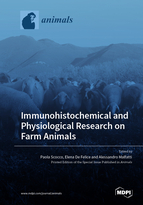Immunohistochemical and Physiological Research on Farm Animals
A special issue of Animals (ISSN 2076-2615). This special issue belongs to the section "Animal Physiology".
Deadline for manuscript submissions: closed (28 February 2021) | Viewed by 60831
Special Issue Editors
Interests: histochemistry; morphometry; animal welfare; food intake; digestive apparatus; reproductive apparatus; mammary gland; ruminants; environmental sustainability
Special Issues, Collections and Topics in MDPI journals
Interests: molecular biology; immunohistochemistry; food intake; regulation of food intake; gut–brain axis; aging; animal models
Special Issues, Collections and Topics in MDPI journals
Special Issue Information
Dear Colleagues,
This Special Issue is dedicated to the application of immunohistochemical and physiological studies carried out on farm animals (swine, sheep, goat, bovine, buffalo, rabbit, poultry, horse, and donkey).
Farm species play very important economic and sociocultural roles, such as food supply, source of income, asset saving, source of employment, soil fertility, livelihood, transport, agricultural traction, agricultural diversification, and sustainable agricultural production. For this reason, it is essential to study in deeper detail the anatomy and physiology of these species. In the last couple of decades, there has been an exponential increase in publications on immunohistochemistry (IHC) and immunocytochemistry techniques, reflecting the currently position that IHC mostly holds in pathological laboratories. This Special Issue will attempt to provide the relevance of immunohistochemical analysis and of their relationships with functions also in farm animals. However, taking into account that multiple methods (Western blot, FISH, etc.) are necessary to perform more reliable conclusions, the use of these methods is also welcomed. Original manuscripts, review articles, as well as short communications are invited. Particularly welcome will be research with a potential applied purpose, studies whose results could be useful in improving farm management practices and the responsible use of natural resources, enhancing the nutraceutical properties of animal derived products, and promoting the circular economy and, in turn, the sustainability of livestock.
You are cordially invited to contribute on this theme or related research topics in order to improve the anatomical and physiological knowledge of farm animals.
Prof. Paola Scocco
Dr. Elena De Felice
Prof. Alessandro Malfatti
Guest Editors
Manuscript Submission Information
Manuscripts should be submitted online at www.mdpi.com by registering and logging in to this website. Once you are registered, click here to go to the submission form. Manuscripts can be submitted until the deadline. All submissions that pass pre-check are peer-reviewed. Accepted papers will be published continuously in the journal (as soon as accepted) and will be listed together on the special issue website. Research articles, review articles as well as short communications are invited. For planned papers, a title and short abstract (about 100 words) can be sent to the Editorial Office for announcement on this website.
Submitted manuscripts should not have been published previously, nor be under consideration for publication elsewhere (except conference proceedings papers). All manuscripts are thoroughly refereed through a single-blind peer-review process. A guide for authors and other relevant information for submission of manuscripts is available on the Instructions for Authors page. Animals is an international peer-reviewed open access semimonthly journal published by MDPI.
Please visit the Instructions for Authors page before submitting a manuscript. The Article Processing Charge (APC) for publication in this open access journal is 2400 CHF (Swiss Francs). Submitted papers should be well formatted and use good English. Authors may use MDPI's English editing service prior to publication or during author revisions.
Keywords
- farm animals (swine, sheep, goat, bovine, buffalo, rabbit, poultry, horse, donkey)
- immunohistochemistry and special staining
- immunohistochemical analysis
- physiological parameters
- endocrinology
- animal behavioral features
- livestock farming
- sustainability









